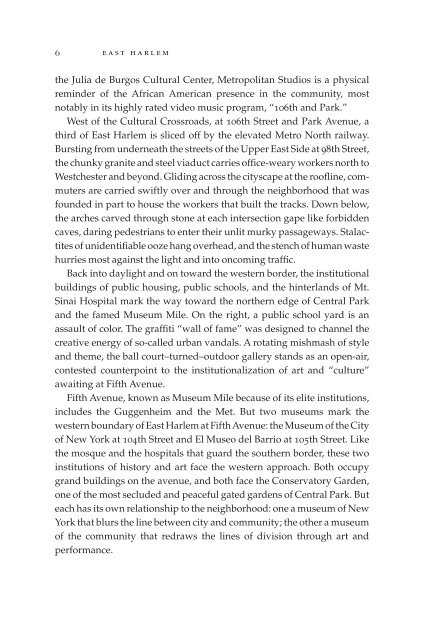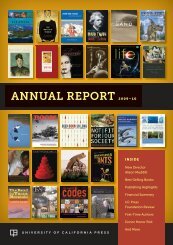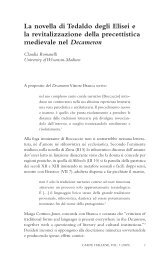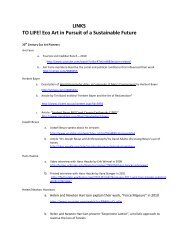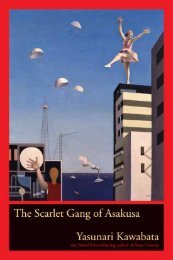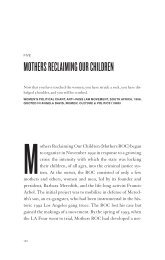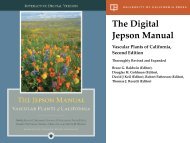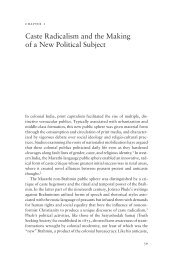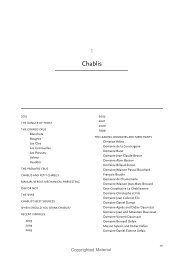Read Chapter 1 (PDF) - University of California Press
Read Chapter 1 (PDF) - University of California Press
Read Chapter 1 (PDF) - University of California Press
Create successful ePaper yourself
Turn your PDF publications into a flip-book with our unique Google optimized e-Paper software.
6<br />
east harlem<br />
the Julia de Burgos Cultural Center, Metropolitan Studios is a physical<br />
reminder <strong>of</strong> the African American presence in the community, most<br />
notably in its highly rated video music program, “106th and Park.”<br />
West <strong>of</strong> the Cultural Crossroads, at 106th Street and Park Avenue, a<br />
third <strong>of</strong> East Harlem is sliced <strong>of</strong>f by the elevated Metro North railway.<br />
Bursting from underneath the streets <strong>of</strong> the Upper East Side at 98th Street,<br />
the chunky granite and steel viaduct carries <strong>of</strong>fice-weary workers north to<br />
Westchester and beyond. Gliding across the cityscape at the ro<strong>of</strong>line, commuters<br />
are carried swiftly over and through the neighborhood that was<br />
founded in part to house the workers that built the tracks. Down below,<br />
the arches carved through stone at each intersection gape like forbidden<br />
caves, daring pedestrians to enter their unlit murky passageways. Stalactites<br />
<strong>of</strong> unidentifiable ooze hang overhead, and the stench <strong>of</strong> human waste<br />
hurries most against the light and into oncoming traffic.<br />
Back into daylight and on toward the western border, the institutional<br />
buildings <strong>of</strong> public housing, public schools, and the hinterlands <strong>of</strong> Mt.<br />
Sinai Hospital mark the way toward the northern edge <strong>of</strong> Central Park<br />
and the famed Museum Mile. On the right, a public school yard is an<br />
assault <strong>of</strong> color. The graffiti “wall <strong>of</strong> fame” was designed to channel the<br />
creative energy <strong>of</strong> so-called urban vandals. A rotating mishmash <strong>of</strong> style<br />
and theme, the ball court–turned–outdoor gallery stands as an open-air,<br />
contested counterpoint to the institutionalization <strong>of</strong> art and “culture”<br />
awaiting at Fifth Avenue.<br />
Fifth Avenue, known as Museum Mile because <strong>of</strong> its elite institutions,<br />
includes the Guggenheim and the Met. But two museums mark the<br />
western boundary <strong>of</strong> East Harlem at Fifth Avenue: the Museum <strong>of</strong> the City<br />
<strong>of</strong> New York at 104th Street and El Museo del Barrio at 105th Street. Like<br />
the mosque and the hospitals that guard the southern border, these two<br />
institutions <strong>of</strong> history and art face the western approach. Both occupy<br />
grand buildings on the avenue, and both face the Conservatory Garden,<br />
one <strong>of</strong> the most secluded and peaceful gated gardens <strong>of</strong> Central Park. But<br />
each has its own relationship to the neighborhood: one a museum <strong>of</strong> New<br />
York that blurs the line between city and community; the other a museum<br />
<strong>of</strong> the community that redraws the lines <strong>of</strong> division through art and<br />
performance.


